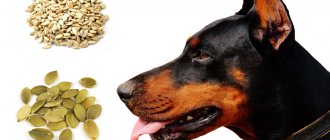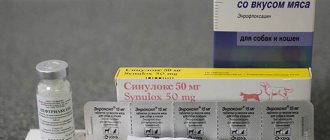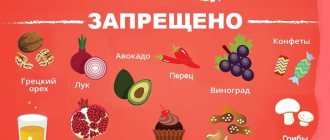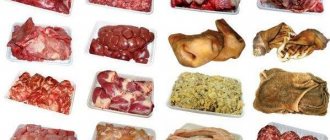12/17/2020 90 527 Dog food
Author: Olga
Nutrition for a dog, like for any pet, plays an important role in its health and well-being. There are certain requirements regarding proper nutrition: there are foods that are healthy for your pet, and there are foods that should not be given to your dog. There is a lot of debate about including chicken bones for dogs on the menu. The article is devoted to this issue.
[Hide]
Should I give it to my pet or not?
The dog's diet should be based on animal proteins, which are found in natural food. For pets, lean meat is suitable, which may contain cartilage and tendons, as well as a small amount of fat. Some meat can be replaced with offal, which includes animal entrails, ears, lips, blood, udder, and bone offal. The legs, joints, heads and bones after cutting the carcass contain protein, which has low biological value, but also a lot of fat. When feeding puppies with bone by-products, you need to add food with a high protein content.
Chicken by-products, such as entrails, paws, skin, bones, heads, necks, skeletons with fat trimmings, have a high energy value and are liked by four-legged pets. Chicken meat rarely causes an allergic reaction in dogs, so it can be used when creating a dietary menu.
Chicken bones
As soon as a puppy appears in the house, the first question that arises is about feeding it. A young body requires a variety of nutrients that are essential for the developing body. Bones are the most important product for puppies; they contain building materials such as protein, calcium, lime, glue, etc. It is useful for young dogs to chew on bones, especially when teeth change between the ages of 4 and 6 months, this speeds up the change process.
Animal bones are useful as a source of calcium. Its meat contains little, more phosphorus, and calcium is more beneficial for dogs than phosphorus. Calcium contained in bones is easily absorbed. If bones are regularly present in the dog’s diet, there is no need for additional calcium supplementation. Bones should be given raw. Gastric juice dissolves them, and they become a source of natural calcium and phosphorus, as well as substances that are material for the formation of joint cartilage. But chicken tubular bones are strictly contraindicated!
It is especially dangerous if the dog has eaten enough boiled bones; when cooked, all the nutrients are removed from them, they change their structure and when they enter the stomach they simply turn into dust.
Long bones are very dangerous, especially for small breeds of dogs. They are fragile and, when chewed, break into sharp pieces that can damage the animal's esophagus, which is why they should not be given.
Bones should not be given as the main food: they are poorly digested and can cause constipation, intestinal obstruction, and volvulus. In adult dogs, bones are quickly worn down by teeth. If a dog has eaten tubular bones, you need to monitor it; if any problems arise, you should immediately consult a doctor.
Soft bones can be given as a treat after your dog has eaten a hearty dinner. A well-fed dog will not greedily gnaw on them, but can prolong its pleasure by savoring the bone for a long time.
Chicken heads
If the dog is not allergic to chicken by-products, then you can feed it chicken heads. Raw heads need to be cut into several particles, add porridge or vegetables with vegetable oil to them. At the same time, there are no tubular bones in the heads, which are harmful to four-legged pets. The only thing is that the beaks should be removed, they have no value, they are not digested. If a dog has eaten heads with beaks, they can cause the animal to burp.
Sorry, there are no surveys available at this time.
Chicken necks
Puppies from the age of two months can be given necks either whole or in the form of minced meat. It is advisable to scald raw necks with boiling water. However, you should not feed them more than three times a week. While there is a danger from small bones in the paws and wings, there are no bones in the necks, so you can safely feed even small dogs. Pets enjoy chewing on them. Adult animals can also be fed chicken necks 1-2 times a week.
Necks can be given to clean teeth and massage gums.
Chicken feet
There are many opinions both for and against. Many people give the paws raw; they are then easily digested by the dog, although the claws must be removed. There is an opinion that it is better to give chicken feet in the form of jellied meat, which will even be useful for growing puppies. If you regularly feed puppies jellied meat, it can replace industrial chondroprotectors.
Preparing jellied meat is not difficult. Place the paws in a thick-walled pan and fill them with water. Bring to a boil, and then, reducing the heat to low, cover the pan with a lid and cook for 5 hours. After cooking, you need to remove the bones, leaving the soft tissue. When the jellied meat has cooled down, you can give it to your pet. Boiled bones should not be given to avoid blockage of the gastrointestinal tract and punctures of the esophagus.
Paws consist of tubular bones, this is one of the reasons why many dog breeders do not give them as food to their pets. If the dog has eaten tubular bones, then you need to monitor its feces. If bloody traces are found, you need to contact a veterinary clinic.
Some dog owners feed their pets paws and porridge all the time, but this should not be done. You cannot feed only paws; they can be given as additional food, but not often, since a lot of toxins and waste accumulate in the bones. The diet should be varied so that the animal receives all the nutrients. When giving raw chicken feet, it is advisable to pour boiling water over them, as they can be dangerous.
Is it possible to feed chicken by-products?
Feeding a dog chicken by-products is a double-edged sword, and even veterinarians do not have a consensus on this matter. On the one hand, in their raw form they can contain harmful bacteria, antibiotics, and other harmful additives. On the other hand, when boiled, the nutritional value is lost.
The issue is especially controversial with chicken heads, paws and other parts containing bones. Boiled bones are not recommended.
Chicken heads
Disputes about whether it is possible to give chicken heads to dogs do not subside on dog breeders forums. Many pet owners say that they give their dogs chicken heads as the main source of protein daily, and the four-legged animals feel great. Proponents of such nutrition remind us that in nature a predator eats its prey with its head, and this does not cause any harm to it.
And although there are no tubular bones in the head, veterinarians do not advise doing this. If you decide to give your animal chicken heads, do not do it every day. The head has little protein and a lot of bones; it cannot replace meat. The beak must be removed. It contains nothing useful and is dangerous for the esophagus.
Dog owners living in rural areas should also remember that a dog accustomed to chicken heads may one day break loose and run out into the street. Such an animal is almost guaranteed to kill all the chickens and other poultry it encounters.
Necks
Necks can be fed even to a puppy older than 3-4 months. They do not contain tubular bones.
Paws
Paws are another very controversial by-product. They contain a lot of collagen and have a rich amino acid composition. Collagen is good for joints, skin and coat.
At the same time, the paws contain those very tubular bones that should absolutely not be given to a dog: their fragments can puncture the esophagus.
If you are going to give your pet chicken feet, remove the bones from them, cut off the claws, and pour boiling water over the feet. You can remove the bones and cook jellied meat from the paws. Jellied meat is beneficial for growing puppies.
Wings
The wings contain the most bones and skin. Giving leather to dogs is not advisable. Therefore, using wings as feed is not recommended.
Bones
Tubular chicken bones should not be given to dogs. They can form sharp chips and damage the intestines. This is especially dangerous for puppies and small breeds.
It is not advisable to give your dog boiled bones. Raw bone in a dog's stomach is successfully digested. But boiled food is not processed and leads to constipation. All valuable substances in bones are destroyed during heat treatment. A boiled bone is essentially rot that does not contain anything useful, but it settles in the stomach and intestines and can accumulate there.
Stomachs, hearts
Chicken stomach and heart contain many healthy vitamins and protein. This food improves the pet’s fur: it takes on a healthy appearance. Use stomachs and hearts as a base for broth, porridge, and add them to vegetables.
Liver
Liver contains a lot of vitamins B12 and A. Boiled liver is very useful, but give it little by little to avoid hypervitaminosis and bone deformation.
Recommendations
Veterinarians' opinions also vary. Australian veterinarian Ian Billinghurst conducted research according to which he found that dogs eating natural food live longer than their counterparts eating food. In his book, he bases his conclusions on the fact that the dog is a carnivore with strong teeth for chewing and tearing meat. In addition, it has a short digestive tract, which contains enzymes that help digest raw animal protein. Therefore, Billinghurst recommends feeding meat bones, such as turkey and chicken wings, as well as necks.
By-products are fed to dogs in kennels. Chicken by-products contain a large amount of collagen, for example, in necks and wings - 20-30%, in paws - 60-70% of the total protein. In heads and paws, digestible protein is 12.3%, and fat is 6.8%. Since chicken fats quickly oxidize even at low temperatures, offal can be stored for no more than 3-4 months. To reduce the risk of contracting infectious diseases, it is better to boil offal or scald it with boiling water.
Veterinarians believe that dogs are different and the reaction of each organism to raw meat products is individual due to the characteristics of the gastrointestinal tract. Therefore, in each case you need to decide personally what food to give your pet.
If the dog was fed dry food from birth, then when switching to chicken by-products, vomiting and diarrhea may occur, since natural food requires more gastric juice than dry food. Therefore, the transition to natural food should be gradual. If the dog ate the food and burped, there is no need to do anything in this case; you can even let the dog eat what it burped.
Industrial goodies
Commercial dog treats are usually dry kibbles (snacks) with an enhanced flavor. There are also sausages, biscuits, etc. It is important to read the ingredients of such products. A high-quality treat should not contain anything unnecessary (preservatives, flavor enhancers, dyes). Low-quality snacks can cause the animal to become constipated and feel worse.
Treats are food that is given once, for example, as a reward during training. It is not recommended to give them constantly. This can negatively affect appetite and digestion.
Treats for animals of the domestic brand TiTBiT are widely available in Russian pet stores. Others include chicken scallops and chicken feet. These are dried crispy paws. According to the manufacturer, it is suitable for dogs of all breeds, including puppies over three months old. Helps clean teeth.
Unfortunately, the reality is not so rosy. The packaging of the paws states in small print that the product contains bone. Let us remind you that this is the same tubular bone that is contraindicated for dogs.
A caring owner always strives to ensure that his dog’s nutrition is healthy and balanced. Many, even novice dog owners, have heard that feeding your pet chicken bones is very dangerous. And indeed it is!
Tubular bones are not digested in the dog's digestive tract. When they are chewed, sharp fragments are formed that can injure the mucous membranes of the animal’s stomach and intestines. As a result of eating a large number of tubular bones, your pet may experience constipation or diarrhea, which is a consequence of disruption of the digestive tract. Eating chicken bones can lead to more severe complications, including surgery and even death.
However, do not think that all chicken products containing bones are harmful to dogs. In particular, I propose to discuss:
How to cook chicken necks for a dog?
Firstly, chicken necks should be given raw.
, since heat treatment destroys
most
of the beneficial substances.
Secondly, I recommend freezing
the chicken necks for two to three days in the freezer.
Thirdly, raw necks must first be thawed and then doused with boiling water
.
If your puppy is a small breed, you can turn
raw chicken necks
through a meat grinder
, and add the resulting minced meat to the dog’s food.
If the puppy is of a medium-sized breed, you can first tap
the chicken necks
with a hammer
to crush the vertebrae contained in them. Large breed dogs can be given chicken and turkey necks, but dogs need to be accustomed to them gradually and in a controlled manner.
IMPORTANT!
Make sure your dog does not swallow pieces of the neck without chewing. Perhaps she is too hungry, so she is in a hurry. In this case, it is better to feed the dog first and give the chicken neck as a snack. You can teach your dog to chew by holding the chicken neck by one end so that the dog takes his time.
two or three chicken necks
one feeding
per week
. This amount will be quite enough to provide the dog with the necessary amount of calcium and phosphorus.
Offal and chicken heads for dogs
Many owners of shaggy dogs are wondering what to feed their dog and whether it can be given chicken by-products. The answer is yes. Poultry meat and bones contain useful substances and vitamins necessary for the health of your pet. The main thing is to cook and serve it correctly.
A dog’s complete nutrition consists of animal proteins, which are found in lean meat, cartilage, and tendons. The diet should also include fats. An inexpensive option that meets these conditions is chicken by-products.
There are several varieties of chicken by-products, depending on the body part of the chicken. For example:
- Heads
. This product contains calcium, so your pet will be happy to eat chicken heads and benefit their teeth. To begin with, the heads are washed, then scalded with boiling water, boiled and only then served to the dog. Before you give the dog a head, you need to remove the beak. Not only does it not contain useful substances, it can damage your pet’s esophagus. Veterinarians advise against overusing this product. They cannot replace a full-fledged piece of head meat, as they do not contain protein. - Paws
. They contain many useful substances: rich in collagen and amino acids. Experts recommend preparing jellied meat from this offal. To begin with, the paws are boiled, then the resulting broth is cooled, and the bones are separated from the offal, the soft tissues are removed, and the claws are removed. Jellied meat will be an excellent addition to porridge, which is cooked separately for your pet. You can only treat your dog with jellied meat. This food is especially useful for puppies. It will have a beneficial effect on the condition of joints, skin and coat. It is better to serve the paws only when they are cleared of bones and claws, otherwise the pet may choke and damage the esophagus. - Necks
. This product can even be given to puppies as it does not contain bones. The necks are boiled, poured over with boiling water and served to the pet. The dog will easily chew on the treat, which is easy to digest. Some owners make minced chicken necks along with other cartilage. - Bones
. Controversy continues to surround this by-product. Some say that bones are strictly forbidden to be given to dogs, while others insist that there is nothing wrong with them. But both agree on one thing: you should never feed your pet tubular bones. The tails cannot chew them and immediately swallow them.
Tubular bones form sharp stakes and damage the intestines. This is especially dangerous for puppies and breeds.
Many experts note that boiled bones are contraindicated for dogs. The fact is that they are poorly digested and make it difficult for your pet to pass stool. Because of this, the pet feels unwell. In addition, no useful substances remain in boiled bones; all of them are destroyed during the cooking process.
Owners who often give their dogs boiled bones may encounter a problem, since, in essence, such a product is rot. This, in turn, clogs the intestines.
Raw bones are healthier. They are given to pets to chew on as they strengthen their teeth. Nevertheless, some owners still recommend giving beef bones for this purpose.
Can dogs have chicken necks?
Dogs can have chicken necks! And not only is it possible, but even necessary! Why chicken necks are good for dogs: 1. they do not contain sharp small and tubular bones that are hazardous to health, 2. it is a nutritious snack for dogs (a source of animal protein), 3. eating chicken necks allows the dog to brush its teeth and massage the gums, 4. speeds up the process of replacing baby teeth with permanent ones (from 4 to 6 months of age), 5. an excellent chondoprotector - a source of easily digestible calcium, 7. dogs really like chicken necks, they chew them with pleasure! 8. When a dog eats chicken necks, it is calm and focused - the house is quiet and things are intact!











